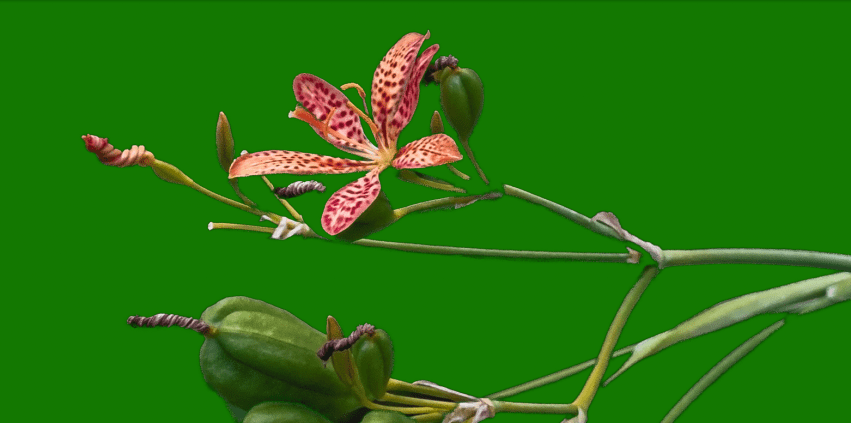From “Blackberry Lily/Leopard Lily (Iris Domestica) in The Illustrated Guide to Nature by The National Georgraphic Society:
“The Blackberry Lily spreads wide its distinctly spotted tepals (look-alike petals and sepals) as if to draw attention to its short-lived beauty, as each blossom lasts only one day.
“A native of China, the Blackberry Lily has escaped cultivation to become widely established in North America. Showy flower sprays appear in the midst of fan-shaped clusters of long, narrow, flat, medium-green leaves. Pear-shaped seedpods form in late summer. When ripe, they split to reveal a cluster of shiny blackberry-like seeds, the source of the plant’s common name; the spots, of course, lend another name — Leopard Lily. A species of a different genus also goes by the name Leopard Lily; Lilium pardalinum, native to California, has somewhat similarly spotted tepals that curl. Its range does not overlap with that of Iris domestica.”
From “Belamcanda” in The Gardener’s Guide to Growing Irises by Geoff Stebbings:
“This genus is native to China, Japan and northern India. The plants look like iris, with fans of quite wide leaves. Given a moist, humus-rich soil they will grow outdoors in temperate zones and should survive most winters, but they are not long-lived plants. There is just one species, B. chinensis, which usually grows to 60cm (2ft) when in flower.
“The inner and outer petals are very similar except that the inner ones are slightly smaller, and the flowers open flat, facing upwards. The petals are orange, spotted with red at the base, and are attractive but not showy. This plant is called blackberry lily because the seed pods open to reveal shiny black seeds.”
Hello!
This is the second of two posts featuring Iris domestica from Oakland Cemetery’s gardens. The first post is Iris Domestica Fireworks (1 of 2).
Here’s one of the images from the galleries below, where you can see some of the unique features of Iris domestica that add to its photographic charm but also serve important botanical purposes. As the flowers age, the petals fold and twist in on each other, forming a tight spiral that retains much of the color from the underside of each petal. This change may occur within a few hours of blooming, as Iris domestica flowers often open and close within a single day.

Coincidentally, they share this trait with daylilies — and their aging process is another example of flower senescence, as I described in one of my previous posts, Red and Yellow Daylilies. This is a complex chemical and biological process, one that enables the plant to conserve energy and retain water, as the spiraled flowers will consume less energy and require less water. The plant can then redirect that energy and water toward the growth of other flowers and stems.
In the classic iris book The Genus Iris by William Rickatson Dykes, the author describes the process for Iris dichotoma, a closely-related iris that exhibits the same behaviors:
“This Iris probably produces more flowers on each stem than any other Iris. The stem is much branched and even the branches often issue in pairs at the same point. Moreover from each spathe as many as five or even more flowers are produced in succession. Each flower, unfortunately, lasts only a few hours and often only opens in the afternoon… However, such is the profusion of flowers that there are usually four or six to be found open at once on each plant.
“Another peculiarity of this Iris lies in the fact that it does not begin to bloom until about the middle of August and then continues in flower for about three weeks or a month. Each flower as it dies twists up in a curious spiral and often falls off together with the ovary between which and the pedicel there is an articulation.”
Sounds complicated, of course, but here we don’t worry too much about chemical and biological mechanisms we don’t (yet!) fully understand. You can click the links above for definitions of the three key botanical terms, if you like, but the process (somewhat speculatively) amounts to this:
The aging flower twists in a spiral, possibly to help the plant conserve water and energy. The position of the twisted spiral at the top of the seedpods helps protect the pods from insect or weather damage, until the pods themselves begin to dry out and open to reveal black seeds inside (the behavior that led to the common name “Blackberry Lily”). The seeds are then distributed by any of several seed dispersal methods, including gravity, wind, rain, and creatures like birds or passerby people.
All this enables the plant to make new plants — so I can take pictures of them again next year. Plants are both smart AND photogenically cooperative!
Thanks for reading and taking a look!






























































































